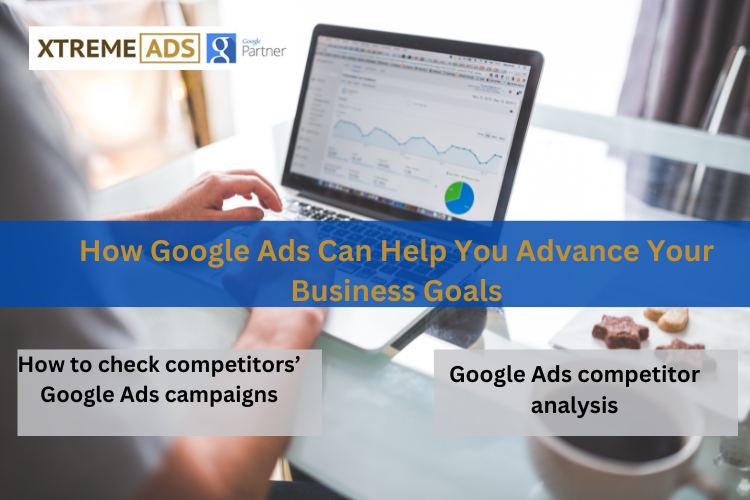Google Ads has revolutionized the digital marketing landscape, allowing businesses to grow, reach their goals, and stay competitive. But here’s a powerful question every business owner and marketer should ask themselves: “How can Google Ads help you advance your business goals and keep you ahead of the competition?”
This blog will walk you through how Google Ads can drive business growth and provide actionable strategies—like competitor analysis and ad transparency—to refine your campaigns and maximize ROI.
If you’re navigating this complex advertising field, this guide, shared by certified Google Ads consultants at XtremeAds, will help you leverage the platform like a pro.
Why Google Ads is Essential for Your Business Growth
Google Ads is one of the most effective platforms to target potential customers at the right time with the right message. It’s not just about ads—it’s about achieving measurable results, whether that’s driving traffic, generating leads, or boosting eCommerce sales.
How Google Ads can help you advance your business goals:
- Precise Targeting: Reach audiences based on location, behavior, device, timing, and even intent.
- Flexibility Across Campaigns: From search to display and YouTube ads, its variety fits different business models and objectives.
- Data-Driven Decisions: Real-time analytics allow marketers to measure performance and tweak strategies on the go.
- Scalability: Easily scale ad spend to reflect business growth while still monitoring ROI.
When used strategically, Google Ads doesn’t just fulfill business goals—it becomes the driving force behind them.
Google Ads Competitor Analysis Done Right
Do you want to know who your competitors are targeting and what strategies they’re using? Competitor analysis in Google Ads is no longer a luxury; it’s a necessity if you want to outperform industry rivals.
Here’s a step-by-step guide on how to check competitors’ Google Ads:
Step 1: Use Google Search
The simplest method to find competing ads is by performing a keyword search for terms relevant to your industry. Pay close attention to the “Ad” labels at the top of search results.
Step 2: Look at Auction Insights
Google Ads’ Auction Insights tool provides key data, such as impression share, overlap rate, and outranking share, highlighting how your ads compare to competitors targeting the same keywords.
Step 3: Explore Ad Transparency Tools
Transparency is taking center stage in digital advertising. Tools like Google’s Ad Transparency Center allow you to see which businesses are advertising on Google and the kinds of ads they’re running. This insight makes competitor analysis more data-driven and efficient.
Step 4: Leverage Third-Party Tools
Platforms like SEMrush, SpyFu, and Adbeat offer more granular insights into competitors’ paid search campaigns. They track ads, budgets, targeted keywords, and even specific ad copies.
Step 5: Analyze Landing Pages
Competitor analysis goes beyond ads themselves. Check out their landing pages to see what CTAs (call-to-actions), copy, and design they’re using to convert users.
Pro Tip: Not sure how to analyze all this data? Reach out to an experienced Google Ads consultant (hint: XtremeAds can help!).
The role of Google ad transparency in campaign success
As brands strive to build trust with their audiences, Google Ads Transparency is becoming more important than ever. It’s not just a compliance measure—it’s an opportunity for businesses to:
- Understand Market Trends:
Transparency features like Google’s Ad Library allow businesses to monitor competitor trends and study ad creativity, budgets, and frequency.
- Promote Brand Accountability:
Transparent advertising practices boost credibility among audiences, improving brand trust and loyalty. This is critical in a world where 88% of consumers research a business before engaging.
- Refine Targeting Strategies:
By reviewing industry-leading ads, you can iterate your strategies, ensuring your advertising aligns with best practices.
When implemented effectively, transparency encourages ethical advertising and creates environments where both businesses and customers benefit.
Top Google Ads Strategies to Achieve Business Goals
Focus on strategies that align with your business goals to elevate your campaigns to the next level. Here’s how Google Ads can drive scalability and profits:
1. Define Clear Objectives
Different campaigns require different strategies. Whether it’s lead generation, sales, or brand awareness, make measurable goals your starting point.
For example:
- Goal: Drive 50% more traffic to your website.
- Strategy: Utilize Google Search Ads with high-performing keywords and detailed ad copy.
2. Focus on High-Intent Keywords
Create a list of long-tail keywords that users are actively searching for. Tools like Google Keyword Planner can identify terms that potential customers are using to make purchasing decisions.
3. Optimize Ad Copy
Grab attention with persuasive ad copy. Include:
- Relevant keywords.
- Clear benefits of your product/service.
- Strong CTAs, such as “Sign Up Today” or “Get Your Free Trial.”
4. Use Remarketing Tactics
Capture lost opportunities by utilizing Google Ads’ remarketing features. Show tailored ads to users who’ve interacted with your website but didn’t convert.
5. Experiment with campaign types.
Maximize campaign performance through diversification:
- Run search Ads for high-intent users.
- Use Display Ads to nurture leads.
- Leverage YouTube Ads for brand narratives.
6. Adjust Real-Time Bidding
Make data-driven adjustments to bids based on geography, audience behavior, and device type. Tools like AI-driven Smart Bidding can help automate processes.
7. Partner with Experts
Running campaigns can be daunting. By collaborating with a team of seasoned specialists—like those at XtremeAds, you ensure expert-level precision, optimization, and results.
Measuring Google Ads Effectiveness
A key part of scaling with Google Ads is understanding performance metrics. Here’s what you should track to ensure proper ROI:
- CTR (Click-Through Rate):
Reflects user engagement with your ads.
- Conversion Rate:
It indicates how effectively visitors are completing desired actions.
- ROAS (Return on Ad Spend):
A measure of profitability.
- Quality Score:
Determines how relevant your ad is to users.
By monitoring these metrics, businesses can not only measure but also optimize their campaigns to scale sustainably.
Keeping Ahead with Google Ads
Competitive advertising isn’t about following others—it’s about learning, adapting, and excelling. By focusing on competitor analysis, leveraging Google Ads transparency, and implementing proven strategies, businesses have the resources they need to grow.
Whether you’re launching your first campaign or struggling to make sense of where your ad budget is going, expert assistance from Google Ads consultants, like those at XtremeAds, can take your business to the next level.
Achieve your business goals faster with data-powered insights, transparent practices, and precision targeting. Start maximizing your Google Ads campaigns today!
FAQ About Google Ads
How can Google Ads help you advance your business goals?
By increasing visibility, driving targeted traffic, and offering scalable strategies, Google Ads aligns directly with actionable business goals.
How to check competitors’ Google Ads?
Use tools like Google’s Ad Transparency Center, Auction Insights, and platforms like SEMrush or SpyFu.
What is Google Ads Transparency?
It refers to Google’s practices of allowing users and businesses to review ad strategies, creatives, and placement for better insight and trust.


